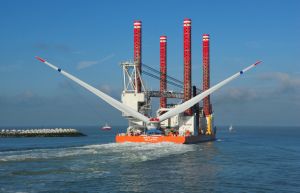Virginia offshore wind developer agrees to avoid right whales for evaluation, but not for construction
Effects of Noise on Wildlife, News, Ocean energy, Wind turbines Add commentsLast fall, Dominion Virginia Power won the first federal lease for developing wind power off the coast of Virginia. As with all offshore energy and Naval activity on the east coast, one of the first environmental concerns to be raised was what measures would be taken to minimize impact on the critically endangered North Atlantic Right whale. While their population has been more or less steadily rising since 1990, with only about 400 individuals, they remain vulnerable to any negative impacts, from ship strikes to increased stress levels, which may reduce reproductive rates and success. (See NOAA’s most recent stock assessment report for details; it notes lower reproductive rates than other Right whale stocks, and concludes that the population will be negatively affected if it loses more than 0.9 whales per year to human impact.)
 With all this in mind, Dominion Virginia Power’s first commitments to the Virginia Offshore Wind Development Authority fell far short of what many had hoped. The company agreed to limit installation activity of test platforms (meteorological towers and preliminary test turbines) during the period when whales are most apt to be migrating past the Virginia coast, but made no such commitments about later, and much more extensive, pile-driving for hundreds of turbines in the eventual wind farm.
With all this in mind, Dominion Virginia Power’s first commitments to the Virginia Offshore Wind Development Authority fell far short of what many had hoped. The company agreed to limit installation activity of test platforms (meteorological towers and preliminary test turbines) during the period when whales are most apt to be migrating past the Virginia coast, but made no such commitments about later, and much more extensive, pile-driving for hundreds of turbines in the eventual wind farm.
“We’re happy to talk” with environmental groups, said Mary C. Doswell, Dominion Resources Inc.’s senior vice president for alternative energy solutions, though she noted, “we can’t overlook the costs of compliance.”
The company said they’d minimize their first-phase activities from late November to late March. The whales spend the summers in a large area off the coast of New England and the Canadian Maritimes, and concentrate at birthing grounds off the coast of northern Florida in winter. NOAA maintains a reduced speed zone along the mid-Atlantic coast, to protect migrating Right whales, from Nov.1 to April 30, close to two months longer than the company set aside as their cautionary season; even the speed restriction is seen by some as a potential obstacle to offshore wind data collection.
UPDATE: See also this article from last fall, which suggests that Dominion plans only to erect a 2-turbine test platform, with full-scae development of 200 or more turbines on hold until costs come down for offshore wind construction. Some wind advocates suggest that Dominion, which has fought renewable energy initiatives in the state, secured the lease largely to prevent others from developing a large offshore capacity.
